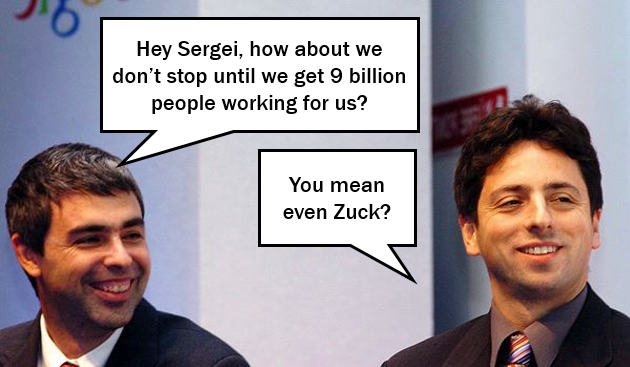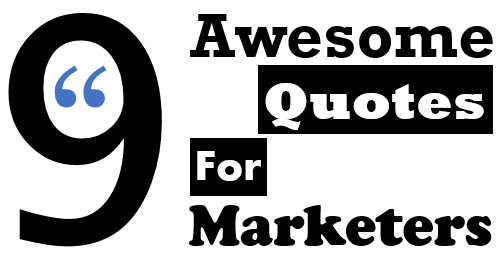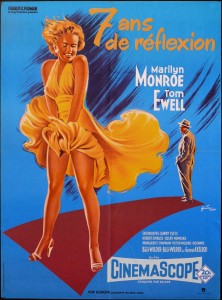 [tweet this]
[tweet this]
I manage a digital agency and I’ve been in online marketing for years. A lot of my connections are in that line of work. Across many industries, blue chips or startups. And yet most marketers I talk to are de facto working for Google.
Google first
When I talk with clients and contacts about building blogs, or creating / redesigning a site, they don’t talk about the end user, the reader, the client or even their president or boss first. No, their first reaction is to mention Google. Will the site be indexed and how well? Which keywords, topics will Google like? How should it be built for SEO.
And then, there is Adwords. The 5 megaton gorilla in the room. The be-all end-all of any marketing budget.
Marketers at companies, big and small, feel compelled to be on Google
I sometimes work with startups who have solutions to a “latent” need. And there you struggle: what type of query will potential customers type into Google? What proxy can we find? Yet, the very fact that their prospects are without the shadow of a doubt on Google (probably to find Lolcats, animated gifs or pics of Jennifer Lawrence) and the fear of missing out make those poor souls worry sick about how to throw their seed money at Google.
As for established players, most often in undifferentiated commodity markets (e.g. retailers, financial institutions, telcos…), Adwords is a bloodbath of epic proportions. All on the same expensive queries. You know what I mean.
[tweet this]
“Are we on that goddamn first page?”
So there you go, dear marketer: you spend most of your time worrying about Google, and indeed working for Google. And yes, if you use Adwords, you pay for the privilege. [tweet this]
Now, has someone ever asked how to differentiate? “Let’s not use Google as the main source of traffic!” Or at least, just considered putting up a decent site and stopping there. Let it get indexed and so be it. Let’s move to more meaningful work. Maybe go talk to a client.
Why it’s not just about Google
Because the truth is Google is a destination for people who already know what they want. You, my marketing-inclined friend, aren’t shaping their desires, creating the spark or influencing their decisions with Google. You’re more like a hitchhiker on the side of the road, hoping someone will get you onboard (e.g. click your ad) and let you coast along (e.g. not bounce once on your page), and then maybe get you up to your destination (e.g. buy or sign up or contact you…).
Unlike Mars, there is life outside Google
Go explore. Build your brand. Surprise your clients and prospects. Delight them if you can. Put on a show. [tweet this]
Take your Google budget and spend it all on a tradeshow booth or blow it on a majestic party for your clients.
Just kidding.
Let’s turn the 20% rule on Google
You know how Google had this policy that their engineers could/must spend 20% of their time on projects outside their job description?
Why not do that with your Google budget and spend 20% on testing other marketing tactics? OK, OK, maybe not 20%. Take 5%. It’s not gonna hurt. Yet, given the size of Search budgets these days, this can amount to a nifty sum to play with.
And every month, try something new.
[tweet this]
Veer off the classics.
If short of inspiration, try the most incongruous or ridiculous thing you can imagine. After all, Volvo Trucks didn’t get to 75M views of their latest stunt with Jean-Claude Van Damme by investing on Adwords.
Street Marketing? Sampling? Staging a protest outside your industry main conference? Blendtec didn’t become an internet sensation by playing it safe! In their “Will it blend?” series, they have shredded, among others, every Apple device to dust and raked millions views and comments in the process.
And guess what? Blendtec doesn’t have to buy “will it blend” on Google.
So, you too fellow marketer, stop working for Google!
Be bold, imagine and experiment!










 Mon premier blog, je l’ai lancé en 2003. J’avais même écrit une application en Java pour l’administrer (Dana) qui avait évolué en un service lancé début 2004 (blogera.com).
Mon premier blog, je l’ai lancé en 2003. J’avais même écrit une application en Java pour l’administrer (Dana) qui avait évolué en un service lancé début 2004 (blogera.com).